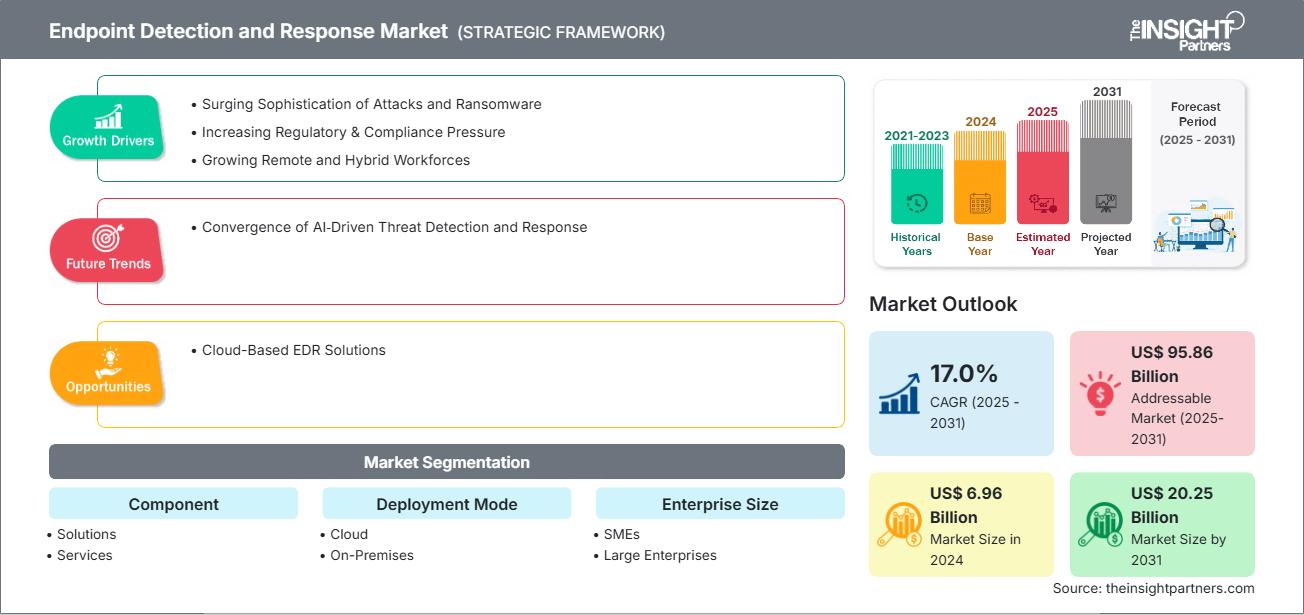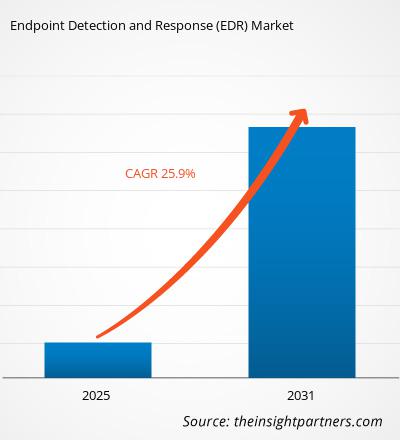预计到 2031 年,端点检测与响应市场规模将从 2024 年的 69.6 亿美元增至 202.5 亿美元。预计该市场在 2025 年至 2031 年期间的复合年增长率为 17.0%。
端点检测与响应市场分析
攻击复杂程度的激增、监管与合规压力和勒索软件的不断增加以及远程和混合劳动力的不断增长,推动了全球端点检测与响应市场规模的增长。传统的防病毒和基于边界的安全工具无法抵御高级威胁,尤其是在攻击者利用人工智能、零日漏洞和社会工程策略绕过防御的情况下。EDR 解决方案通过在端点级别提供实时可见性、行为分析和直接事件响应功能来弥补这些差距。 2024 年第一季度,反网络钓鱼工作组 (APWG) 记录了 963,994 个独立网络钓鱼网站,而第二季度则下降至 877,536 个。
端点检测与响应市场概览
端点检测与响应 (EDR) 是一种网络安全解决方案,旨在监控、检测和响应连接到网络的端点上的威胁。EDR 工具可以监控文件或用户中的可疑活动。EDR 系统会标记这些活动,记录详细信息,并采取措施(例如隔离设备或终止恶意进程)来阻止潜在的漏洞。它提供高级威胁检测和实时响应功能,保护组织免受不断演变的网络威胁。EDR 工具会持续收集和分析来自端点的数据,查找可能表明存在恶意软件、未经授权的访问或其他安全事件的可疑活动。通过利用行为分析、机器学习和威胁情报,EDR 可帮助安全团队识别传统防病毒解决方案可能遗漏的威胁。
此外,EDR 系统支持快速调查并自动或手动响应,以遏制和补救攻击,从而减少潜在损害和停机时间。这些功能使 EDR 对于现代 IT 环境中的事件响应、威胁搜寻和整体安全态势的提升至关重要。
自定义此报告以满足您的要求
您将免费获得任何报告的定制,包括本报告的部分内容,或国家级分析、Excel 数据包,以及为初创企业和大学提供超值优惠和折扣
端点检测和响应市场: 战略洞察

- 获取本报告的主要市场趋势。这个免费样本将包括数据分析,从市场趋势到估计和预测。
端点检测与响应市场驱动因素和机遇
市场驱动因素:
您将免费获得任何报告的定制,包括本报告的部分内容,或国家级分析、Excel 数据包,以及为初创企业和大学提供超值优惠和折扣
端点检测和响应市场: 战略洞察

- 获取本报告的主要市场趋势。这个免费样本将包括数据分析,从市场趋势到估计和预测。
攻击和勒索软件复杂程度激增:
勒索软件攻击变得尤为普遍,针对具有日益复杂的有效载荷的组织和行业。日益增加的监管与合规压力:
随着网络威胁变得越来越复杂,世界各地的监管机构都在执行更严格的网络安全标准。远程和混合劳动力的增长:
疫情后向远程工作的转变扩大了攻击面,增加了对跨分布式设备的端点保护的需求。
市场机遇:
- 与扩展检测与响应 (XDR) 平台:供应商正在将其 EDR 产品扩展到更广泛的 XDR 生态系统,从而实现跨端点、网络、云和电子邮件安全的统一可视性。
- 中小企业市场渗透:随着 EDR 通过基于 SaaS 和托管的模型变得更加经济实惠,越来越多的中小型企业开始采用这些工具。
- 人工智能驱动的自动化和威胁搜寻:人工智能和机器学习增强功能为改进威胁预测、减少误报和自动化 EDR 平台中的响应操作提供了机会。
端点检测和响应市场报告细分分析
端点检测和响应市场分为不同的细分市场,以便更清楚地了解其运作方式、增长潜力和最新趋势。以下是大多数行业报告中使用的标准细分方法:
按组件:
解决方案:
端点检测和响应 (EDR) 解决方案可持续监控并实时检测笔记本电脑、台式机和服务器等端点上的威胁。服务:
此服务专注于识别传统防病毒解决方案经常遗漏的可疑活动、潜在漏洞和高级威胁。
按部署模式:
云:
云端点检测和响应 (Cloud EDR) 是现代网络安全策略的重要组成部分,旨在为在云环境中运行的端点提供高级威胁检测、调查和响应功能。本地:
本地端点检测和响应 (EDR) 是一种部署在组织本地基础架构内的安全解决方案,用于监控、检测和响应针对台式机、笔记本电脑和服务器等终端设备的网络威胁。
按企业规模划分:
中小企业:
随着网络威胁日益复杂,端点检测和响应 (EDR) 解决方案对于中小型企业 (SME) 来说变得越来越重要。大型企业:
在大型企业中,EDR 解决方案在保护地理分散网络中的大量设备方面发挥着关键作用。
按最终用户行业划分:
- BFSI
- IT 和电信
- 医疗保健
- 零售
- 政府
- 制造业
- 其他
每个行业都有特定的 EDR 要求。它会影响端点保护和功能偏好。
按地域划分:
- 北美
- 欧洲
- 亚太地区
- 南美和中美洲
- 中东和非洲
亚太地区的端点检测与响应市场预计将实现最快的增长。智能手机使用率的提高以及一些政府鼓励端点保护,这些因素都可能推动市场发展。
端点检测和响应市场区域洞察
The Insight Partners 的分析师已详尽阐述了预测期内影响端点检测和响应市场的区域趋势和因素。本节还讨论了北美、欧洲、亚太地区、中东和非洲以及南美和中美洲的端点检测和响应市场细分和地域分布。
端点检测和响应市场报告范围
| 报告属性 | 细节 |
|---|---|
| 市场规模 2024 | US$ 6.96 Billion |
| 市场规模 2031 | US$ 20.25 Billion |
| 全球复合年增长率 (2025 - 2031) | 17.0% |
| 历史数据 | 2021-2023 |
| 预测期 | 2025-2031 |
| 涵盖的领域 |
By 组件
|
| 覆盖地区和国家 | 北美
|
| 市场领导者和主要公司简介 |
|
端点检测和响应市场参与者密度:了解其对业务动态的影响
终端检测与响应市场正在快速增长,这得益于终端用户需求的不断增长,而这些需求的驱动因素包括消费者偏好的演变、技术进步以及对产品优势的认知度的提升。随着需求的增长,企业正在扩展其产品线,不断创新以满足消费者需求,并抓住新兴趋势,从而进一步推动市场增长。

- 获取 端点检测和响应市场 主要参与者概述
按地区划分的端点检测和响应市场份额分析
预计未来几年亚太地区将增长最快。南美和中美、中东和非洲的新兴市场也为端点检测和响应提供商提供了许多尚未开发的扩张机会。
每个地区的端点检测和响应市场增长情况不同。这是由于数字技术、政府法规和网络攻击日益增多等因素造成的。以下是按地区划分的市场份额和趋势摘要:
1. 北美
市场份额:
占全球市场的很大一部分关键驱动因素:
- 高网络攻击量
- 合规性要求(例如,CISA 指南、SEC 网络规则)迫使企业投资 EDR。
- 混合工作模式增加了端点漏洞,推动了对 EDR 解决方案的需求。
趋势:
企业正在将 EDR 与扩展检测和响应 (XDR) 合并,以实现跨平台威胁可见性。
2. 欧洲
市场份额:
由于早期采用数字商务而获得大量份额关键驱动因素:
- GDPR 和 NIS2 合规性
- 国家支持的攻击增加
- 中小企业采用
趋势:
供应商正在嵌入 AI/ML 以进行实时异常检测,从而减少误报。
3.亚太地区
市场份额:
增长最快的地区,市场份额每年都在增长关键驱动因素:
- 数字化转型
- 关键基础设施攻击
- 政府举措
趋势:
由于内部技能短缺,外包 EDR 解决方案越来越受到青睐。
4.南美和中美洲
市场份额:
虽然规模较小,但增长迅速关键驱动因素:
- 金融部门增长
- 地缘政治网络风险
趋势:
与威胁源(例如 DarkMatter、Group-IB)集成以提供上下文警报。
5.中东和非洲
市场份额:
市场稳步增长关键驱动因素:
- 金融科技繁荣
- 监管压力
趋势:
初创企业和中小型企业采用基于 SaaS 的 EDR 工具,以实现可负担性和可扩展性。
端点检测和响应市场参与者密度:了解其对业务动态的影响
高市场密度和竞争
由于 CrowdStrike、Microsoft 和 SentinelOne 等老牌参与者的存在,竞争非常激烈。 Tenable(印度)、Blockbit(拉丁美洲)和卡巴斯基(欧洲)等区域性和利基供应商也加剧了不同地区的竞争格局。
这种激烈的竞争促使公司通过提供以下产品脱颖而出:
- 高级安全功能
- 增值服务,如分析和勒索软件检测
- 有竞争力的定价模式
- 强大的客户支持和轻松的集成
机遇和战略举措
- 渠道合作伙伴(MSP、云提供商)推动规模发展。
- 将 EDR 与网络/云安全合并。
在端点检测和响应市场运营的主要公司有:
- CrowdStrike Holdings Inc.(美国)
- Palo Alto Networks Inc.,(美国)
- Fortinet Inc., (美国)
- Microsoft Corp,(美国)
- SentinelOne Inc.(美国)
- Broadcom Inc.(美国)
- Cisco Systems Inc.(美国)
- Trend Micro Inc.(日本)
- Zoho Corp Pvt Ltd(印度)
- Sophos Ltd(英国)
免责声明:以上公司排名不分先后。
研究过程中分析的其他公司:
- ESET
- FireEye
- Fortinet
- Kaspersky
- McAfee
- VMware Carbon Black
- Cybereason
- Tanium
- Cylance(黑莓)
- RSA Security
- Symantec
- Panda安全
- OpenText
- Malwarebytes
- HCL Technologies
端点检测和响应市场新闻及最新发展
CrowdStrike 和 ExtraHop 扩大了合作伙伴关系
CrowdStrike 和 ExtraHop 扩大了合作伙伴关系,以解决围绕影子人工智能 (shadow AI) 日益增长的安全问题——员工绕过组织监督未经授权使用人工智能工具和服务。此次集成在 RSAC 2025 上宣布,将 ExtraHop 的网络遥测数据馈入 CrowdStrike 的 Falcon Next-Gen SIEM,使安全运营中心 (SOC) 能够实时监控、检测和响应未经批准的人工智能使用行为。该联合解决方案使 SOC 团队能够跨端点、网络、云和本地环境获得企业范围的可视性。Sophos 宣布与 Pax8 建立战略合作伙伴关系
Sophos 是全球领先的创新安全解决方案提供商,致力于抵御网络攻击,现已宣布与领先的云商务平台 Pax8 建立战略合作伙伴关系。此次合作将为 Pax8 超过 40,000 家托管服务提供商 (MSP) 网络带来最全面的网络安全解决方案组合。Pax8 网络中的 MSP 可从单一供应商处获得完整的一站式一流网络安全解决方案,包括 Sophos 托管检测和响应 (MDR)、由 Intercept X 提供支持的 Sophos Endpoint 以及 Sophos 防火墙。这为渠道合作伙伴带来了革命性的机会,使他们能够简化运营、简化计费流程,并降低客户网络安全管理的复杂性。
端点检测和响应市场报告覆盖范围和可交付成果
《端点检测和响应市场规模和预测(2021-2031)》报告对市场进行了详细的分析,涵盖以下领域:
- 端点检测和响应市场规模以及涵盖范围内所有关键细分市场的全球、区域和国家/地区预测
- 端点检测和响应市场趋势,以及市场动态,例如驱动因素、限制因素和关键机遇
- 详细的 PEST 和 SWOT 分析
- 端点检测和响应市场分析,涵盖关键市场趋势、全球和区域框架、主要参与者、法规和最新市场发展
- 行业格局和竞争分析,涵盖市场集中度、热图分析、知名参与者和端点检测和响应市场的最新发展
- 详细的公司简介
- 历史分析(2 年)、基准年、预测(7 年)及复合年增长率
- PEST和SWOT分析
- 市场规模、价值/数量 - 全球、区域、国家
- 行业和竞争格局
- Excel 数据集
近期报告
客户评价
购买理由
- 明智的决策
- 了解市场动态
- 竞争分析
- 客户洞察
- 市场预测
- 风险规避
- 战略规划
- 投资论证
- 识别新兴市场
- 优化营销策略
- 提升运营效率
- 顺应监管趋势




















 获取免费样品 - 端点检测和响应市场
获取免费样品 - 端点检测和响应市场